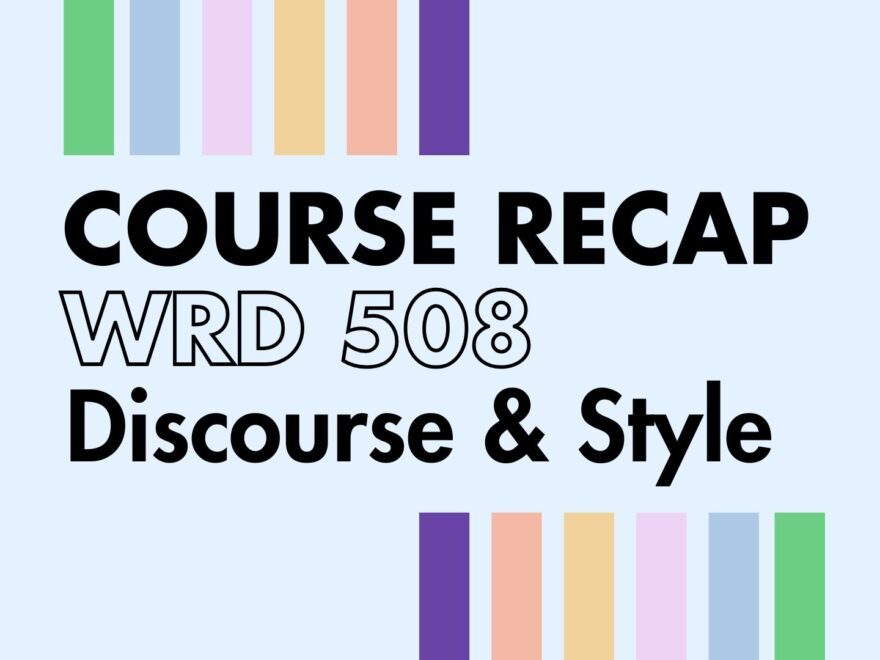In Winter Quarter 2025, Dr. Antonio Ceraso taught WRD 508 Discourse & Style. In this class, students approached written style from a rhetorical perspective, examining how style on a micro and macro level can work to accomplish persuasive goals. By exploring methods and terminology for analyzing style and reading a wide range of genres, students ultimately worked to develop their own stylistic repertoires.
The class focused on analyzing the relationship between stylistic choices, rhetorical purpose, and rhetorical effects. Throughout the process, students reflected on and articulated their stylistic decision-making as integral to the writing process. Considering their own writing in this way, and considering the broader framework that writing exists in, students began to understand the relationship between style and discourse—including forms of power and cultural transmission that shape, prescribe, and police language.
To provide a recap of the course from a student perspective, I chatted with MAWRD student Tabitha Jou Yi, a fellow classmate in WRD 508 Discourse & Style. Sharing her view of the class from her position as a high school Language Arts teacher, Tab helped provide insight into what the class was like and what it taught her.
Tab’s Take
Tab shared that she thought the course was very helpful, especially in the way that it informed students of rhetorical choices and figures. Teaching AP Language, Tab educates her high school students on these concepts already, but the course provided a refreshing broadening of the typical moves. Beyond just introducing students to more rhetorical devices they had never heard of, and rather than having students memorize terms, the course invited students to explore the wide range of rhetorical devices to see how they might be applied in their own writing.
What We Learned
Tab described the class as “eye opening.” One reading from the class she used to illustrate this point was Vershawn Ashanti Young’s “Should Writers Use They Own English?”. This reading stuck out to Tab because it was an academic article written in African American Vernacular English (AAVE), which she had never seen done before. Tab compared this article to a classic text that they use in the high school space: They Say I Say by Graff and Birkenstein. She explained that the text has many sentence templates and discusses typical academic writing moves to teach students how to speak academic language. But, Young’s article from class being an academic piece in AAVE that was still seen and interpreted as valid and worth studying showed Tab that genre conventions are conventions for a reason—sometimes as manifestations of dominant ideologies at play—but that doesn’t make the conventions inherently the right way to do something.
Tab expanded that the stereotype of the English teacher holding the red pen and marking up papers doesn’t resonate with her teaching style; the lessons she learned in WRD 508 Discourse & Style showed her that she prefers the approach of helping students find their voice—whatever it may be—and teaching them ways they can express it using rhetorical tools.
Final Project
Students in WRD 508 Discourse & Style had two options for their final project. The first option was to write an entirely new stylistic analysis of an existing work, and the second option was to majorly revise one of their own previously written academic texts and reflect on the process.
Tab chose the latter, taking an old piece she had written for WRD 514 Sociolinguistics and revising it with improved style. In the reflection, she shared how that she often feels a time pressure in academic writing due to submission deadlines, so she chooses to spend her limited time focusing more on developing the content of her essays rather than the style. She found that the stylistic revision provided her room to find her own voice, rather than replicating her internalized notion of the Academic Voice. In particular, she appreciated utilizing the class textbook, Eric Hayot’s The Elements of Academic Style, to see how she could apply its principles to her own writing.
Expectations vs. Reality
When I asked Tab how the class ended up going compared to her initial expectations, she was emphatic that it was surprising and went above her expectations. She noted that at certain points it felt like WRD 508 students were back in the grammar English classroom, doing worksheets and such; yet, even in this setting, she still felt that there was “a certain element of expression, of finding one’s own voice and style.” Rather than the lessons being prescriptive or restrictive, Tab found them freeing. She shared that it gave her space to experiment, and that the process was rewarding. Tab clarified that she is not a creative writer, but the class exercises and activities allowed her to creatively roam within the academic genre.
Conclusion
Ultimately, WRD 508 Discourse & Style was a compelling and transformative experience for its students. Dr. Ceraso’s guidance, feedback, and support allowed students to explore their unique voices while learning specific skills and strategies that could guide their work.
To keep up to date with other course offerings, be sure to check out the Course Spotlights tab here on the WRD Blog.
